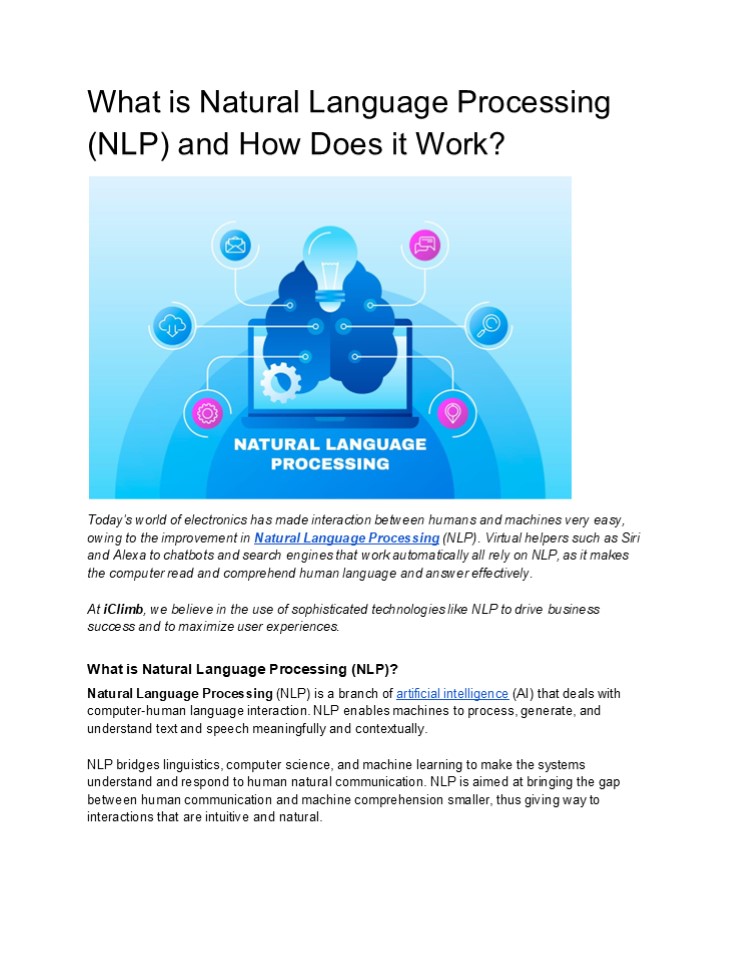What is Natural Language Processing (NLP) and How Does it Work?
Title:
What is Natural Language Processing (NLP) and How Does it Work?
Description:
Today’s world of electronics has made interaction between humans and machines very easy, owing to the improvement in Natural Language Processing (NLP). Virtual helpers such as Siri and Alexa to chatbots and search engines that work automatically all rely on NLP, as it makes the computer read and comprehend human language and answer effectively. –
Number of Views:0
Title: What is Natural Language Processing (NLP) and How Does it Work?
1
What is Natural Language Processing (NLP) and How
Does it Work?
Today's world of electronics has made interaction
between humans and machines very easy, owing to
the improvement in Natural Language Processing
(NLP). Virtual helpers such as Siri and Alexa to
chatbots and search engines that work
automatically all rely on NLP, as it makes the
computer read and comprehend human language and
answer effectively. At iClimb, we believe in the
use of sophisticated technologies like NLP to
drive business success and to maximize user
experiences. What is Natural Language Processing
(NLP)? Natural Language Processing (NLP) is a
branch of artificial intelligence (AI) that deals
with computer-human language interaction. NLP
enables machines to process, generate, and
understand text and speech meaningfully and
contextually. NLP bridges linguistics, computer
science, and machine learning to make the systems
understand and respond to human natural
communication. NLP is aimed at bringing the gap
between human communication and machine
comprehension smaller, thus giving way to
interactions that are intuitive and natural.
2
- How Does NLP Work?
- NLP is achieved through a series of sophisticated
processes that allow machines to disassemble and
decipher human language. It takes many steps,
some of which include text processing, syntactic
and semantic analysis, machine learning models,
and deep learning algorithms. - Text Processing
- Text has to be cleaned and formatted before it
can be processed on a computer. Text
preprocessing is performed through a series of
processes - Tokenization Split a sentence into words or
phrases (tokens). - Stopword Removal Deleting words like "is,"
"the," and "and" that contribute minimal meaning. - Stemming Lemmatization Converting words to
their base forms. For instance, "running" is
converted to "run." - Part-of-Speech (POS) Tagging Determining nouns,
verbs, adjectives, etc., to determine sentence
structure. - Syntactic Analysis
- Parsing is employed to determine the grammatical
structure of a sentence. It entails - Dependency Parsing Determine word relationships
(e.g., "John gave Mary a book" ? "John" is a
subject, "gave" is a verb, "Mary" is an indirect
object). - Chunking Bunching words into tidily stated units
like a verb or a noun phrase.
3
- Supervised Learning Model training with labeled
datasets to make predictions. - Unsupervised Learning Pattern recognition from
unlabeled unstructured data. - Transformers Deep Learning Advanced models
like BERT, GPT, and T5 use neural networks to
produce human-like results. - 5. Speech Processing
- In voice assistant and speech-to-text functions,
NLP brings together speech-to-text and
text-to-speech. Algorithms read phonetics,
intonation, and accent to translate human speech
accurately. - Applications of NLP in Real Life
- NLP in Artificial Intelligence has many uses in
different industries to facilitate communication,
automate processes, and enhance user interaction.
Let us talk about some of the main uses. - Chatbots and Virtual Assistants
- NLP is used by virtual assistants like Siri,
Google Assistant, and Alexa to recognize and
respond to questions from the users, providing
relevant information or carrying out operations
like reminding and messaging. - Search Engines and Web Crawlers
- Search engines such as Google and Bing utilize
NLP to interpret user intent, rank websites, and
offer precise search results. NLP assists in
narrowing searches through synonyms, context, and
user behavior. - Sentiment Analysis in Business and Marketing
- Companies use NLP-powered sentiment analysis to
examine customer opinions on social media,
reviews, and surveys. This helps brands gauge
public opinion and make evidence-based decisions.
4
- Health Care and Medical Diagnostics
- NLP finds application in medical record analysis,
disease forecasting, and computerized diagnosis.
It aids the retrieval of information from patient
histories and scientific literature. - Fraud Detection and Cyber Security
- Financial institutions and banks employ NLP in
the detection of fraudulent transactions, the
detection of phishing attacks in email
communications, and in improving cybersecurity. - Challenges in NLP
- While NLP has come a long way, there are certain
problems - Language Ambiguity Words and sentences can have
multiple meanings based on the context. - Sarcasm Irony Detection Sarcasm detection in
text is still a battle uphill. - Multilingual Understanding NLP models are not
good with low-resource languages. - Bias in AI Models AI models are biased based on
training data, hence leading to wrongful or
unfair results. - Real-Time Processing It is hard to achieve fast
and accurate real-time language processing. - The Future of NLP
- The future of NLP is promising and exciting. With
deep learning, reinforcement learning, and AI
ethics, NLP is getting more powerful and
advanced. - Conversational AI Virtual assistants and
chatbots will become even more context-aware and
natural.
5
With AI and deep learning advancements, NLP will
become even better at being more intelligent,
intuitive, and sensitive in detecting and
recognizing complex human emotions and dialogues.
We see the potential at iClimb and would like to
enable businesses to harness it for greater
efficiency and growth. Read More
- https//iclimbs.wordpress.com/2025/04/03/what-is
-natural-language-processing-nlp-and-how-do
es-it-work/































